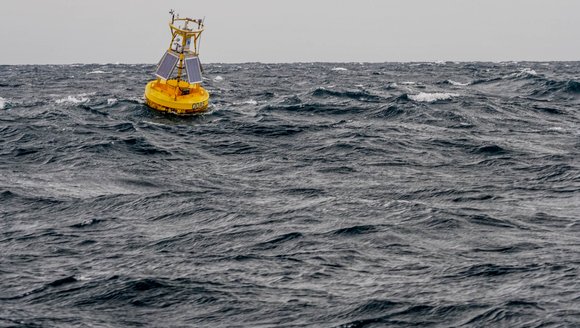Gulf of Maine, Explained: Tracking Ocean Conditions
Gulf of Maine, Explained | Jun 7, 2024
GMRI Senior Program Manager, and leader of our Ocean Data Products team, Riley Young-Morse explains how she uses deep water buoys to collect data on near real-time ocean conditions at sea.
In this edition of Gulf of Maine, Explained, Riley Young Morse, talks about her work with seven deep water oceanographic buoys, managed by NERACOOS, that provide near real-time data around ocean conditions.
These buoys, which stand six to eight feet tall and are equipped with numerous sensors, collect data on various ocean conditions such as waves, winds, temperature, and current speed and direction. Sensors along their anchor chains, which can extend over 250 meters deep, provide additional readings on salinity, pH, and more.
Data is recorded every six minutes to an hour, and stored on a small computer within the buoy. That data is transmitted from the buoy's computer to the University of Maine using cell phone or satellite technology, depending on how far the buoys are from shore. The university sends this raw data to Riley and her team, who then transform it into usable information for all kinds of stakeholders who might want to know about current ocean conditions.
The buoy data serves two primary purposes. First, it provides real-time information on ocean conditions, which is crucial for people making decisions about whether or not it's safe to go to sea, such as fishermen, ferry captains, sailors, and even surfers. Second, the long-term collection of buoy data helps researchers understand trends and patterns in the Gulf of Maine, offering insights into environmental changes over time and how those changes might be affecting marine ecosystems.
A Closer Look at our Deep Water Buoy Work
Observing the Ocean
The ocean is a big, ever-changing system. Fish are constantly moving around and weather conditions can change in an instant. This makes studying marine ecosystems …
Perspectives|May 28, 2024
Gulf of Maine, Explained
In our video series, The Gulf of Maine, Explained, you’ll learn more about important-but-unfamiliar concepts related to our work. We’ll cover commercial fishing, fisheries research, sustainable seafood, education, and more. While we probably won’t answer all your questions in one short video, we hope to spark your curiosity about complicated issues that are central to our mission.




